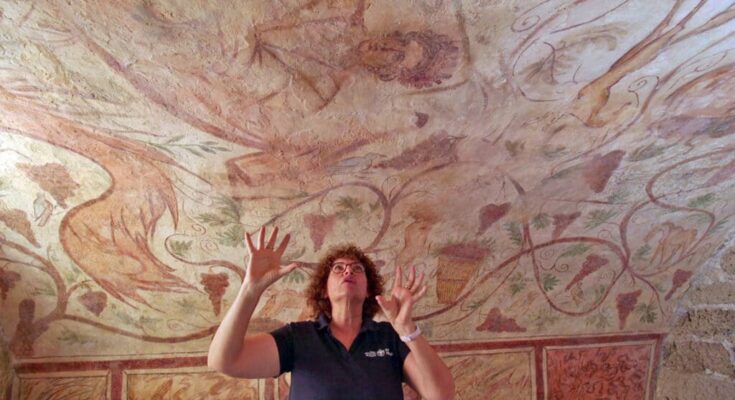
Two vaulted tombs with rare Greek drawings dating back at least 1,700 years are soon to be revealed to the public for the first time in Ashkelon, Israel.
According to Israel21c, the unveiling of these tombs is part of a broader initiative by the southern seaside city and the Israel Antiquities Authority to integrate local heritage assets into public spaces.
Located near Ashkelon’s marina, these tombs showcase an artistic array of Greek mythological characters, people, plants and animals. The structures, discovered in the 1930s, have undergone extensive conservation.
Drawings of Greek mythical figures adorn the tombs
One tomb, dating to the early fourth century CE, features depictions of Demeter, the Greek goddess of harvest, grain and earth’s fertility, alongside various nature scenes including vines, grape clusters, greenery and some magic nature ladies (nymphs).
For ancient Greeks, every waterway was protected by nymphs. These were invariably ageless young girls who existed even before the Olympic gods and long before the birth of mortals.
A rendering of Medusa, a mythical gorgon the most fearsome figure of Greek mythology, is also among the many artistic portrayals in the tomb.
Μέδουσα (as ‘Medusa’ is spelled in Greek), meaning “guardian, protectress,” who was also referred to as Gorgo, was one of the three monstrous gorgons, generally described as winged human females with living venomous snakes in place of hair. Those who gazed into her eyes would turn to stone.
The second tomb, which was relocated from another Ashkelon site in the 1990s, dates back to the second century CE. It boasts colorful paintings of human figures, birds, deer and other flora and fauna, and also features several lead coffins decorated with similar motifs.
Mark Abrahami, head of the Israel Antiquities Authority’s art conservation branch, credited the “relatively closed structure” of the tombs for the good state of the artwork they house, noting that there was still plenty of work to be done to make sure they remain intact.
“Naturally, exposure of the centuries-old paint to air and moisture caused fading and weathering. We had to conduct a long and sensitive process to stop and repair the ravages of time and weathering. Some paintings had to be removed from the walls for thorough treatment in the Israel Antiquities Authority’s conservation laboratories until they were returned to the site,” said Abrahami.
“The other walls of the structure were cleaned, the pigments in the colors of the paintings were accentuated, and the entire building was strengthened and stabilized to preserve it for future generations,” he said, according to Israel21c.
Related: Cargo From ‘Most Ancient’ Shipwreck Found off Israel



